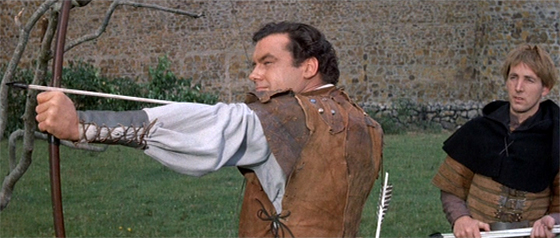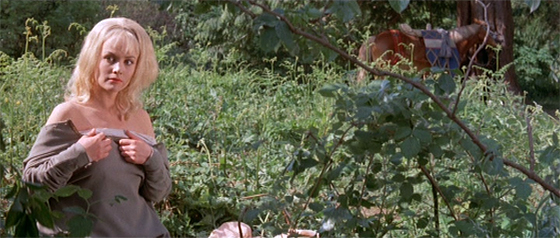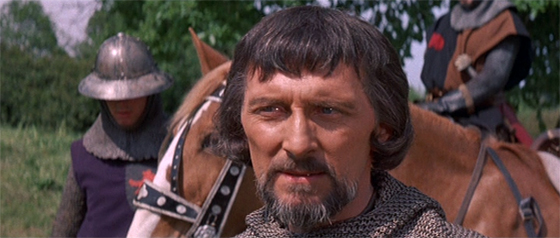
Television may have been cinema’s chief competitor, but Hammer Films was never afraid to mine the small screen for inspiration, from its eerie adaptations of Nigel Kneale serials (the Quatermass trilogy, The Abominable Snowman) to the feature-length sitcoms of the studio’s waning years (On the Buses, Man About the House). Sword of Sherwood Forest (1960), likewise, cashes in on the audience’s familiarity not only with the Robin Hood character but with the Richard Greene-starring Adventures of Robin Hood TV series which ran from 1955 to the year of this film’s release, 1960. That was a good year for Hammer. The previous years had seen the birth of “Hammer horror” to terrific box office; Peter Cushing was emerging as the studio’s marquee star, and Christopher Lee was quickly building a fan base as their in-house Karloff. But while James Carreras, Anthony Hinds, and Michael Carreras guaranteed there was more horror product in the pipeline, they also continued to diversify their output with dramas, suspense, comedy, and swashbuckling adventure. Sword of Sherwood Forest fit right in, a typical example of Hammer’s style from that period: adapt a known (usually literary) property, gloss it up with some first-rate actors, color, beautiful widescreen (“Megascope”) cinematography and a fine score – and, if at all possible, put Terence Fisher on the job. Fisher had proven himself adept at turning small budgets into classy, noteworthy productions. He was the man to ensure that the big-screen Robin Hood looked much grander than the television version.

Typically intelligent use of widescreen storytelling from Terence Fisher: while Maid Marian (Sarah Branch) quietly dresses following a swim, the whinny of her horse (at right) gives away her position to Robin Hood and his men.
Unusually for a Hammer film, the star (Greene) was also the co-producer; but if Greene had better leverage on set to protect his idea of the Robin Hood character, Sword of Sherwood Forest doesn’t feel like a vanity project – just classic Hammer. A new supporting cast is brought in, many of them from the studio’s repertory company. (This was the studio’s second go at Robin Hood. The Men of Sherwood Forest was released in 1954, directed by Val Guest.) Most notably, the Sheriff of Nottingham is now played by Cushing. You could say he was born to play the role, but I think the same of his performances as Van Helsing, Dr. Frankenstein, and Sherlock Holmes. Cushing presents the villain in an intriguing fashion: we can see his motives, his point of view – he’s an agent of the government who considers the Merry Men nothing more than terrorists. It’s only when we see him brutally betraying and murdering one of Robin Hood’s friends that we remember what a scoundrel he is. And still, he’s not the most evil man about. Oliver Reed – Hammer’s own werewolf – rides into town with stormy eyes, a falcon on his arm, and a nasal whine in his voice; playing Lord Melton, he’s accompanied by the young Earl of Newark, played by The Gorgon‘s Richard Pasco. The Earl’s cleverness appeals to Robin Hood, but disguises a secret agenda. Beautiful Sarah Branch – Maid Marian – previously appeared in a Hammer noir, Hell is a City (1960). Robin’s best mate, Little John, is ideally cast with Nigel Green, who would later appear in Hammer’s Countess Dracula (1971), but to me will always be the brawny and big-hearted Hercules from Jason and the Argonauts (1963). Also present is Jason‘s Zeus, distinguished character actor Niall MacGinnis, here playing the comic relief as Friar Tuck.

The Sheriff of Nottingham (Peter Cushing) threatens to kill a hostage if he doesn't reveal the location of Robin Hood's hideout.
I didn’t grow up on the Adventures of Robin Hood series, so – to my eyes – Richard Greene seems a bit too old and bourgeois for the role, and not quite the young and athletic rebel I expect. (He’s no Errol Flynn, but is he preferable to Kevin Costner? By miles.) This is most distracting when he’s romantically paired with Sarah Branch, who was twenty years his junior. But this is a quibble. Greene is obviously comfortable in the role, which translates through his performance regardless of your familiarity with the TV series. When he picks up the bow for some trick-shot competition with the Earl of Newark, Fisher milks just the right level of iconic excitement you expect to get from the character, in the same way that Fisher maximized Dracula’s seductive bites and Sherlock’s feats of deduction. The plot is a somewhat unusual mishmash of origin story and series finale. Robin has never met Maid Marian before, and King Richard is still abroad, but the bandit’s ongoing confrontations with the Sheriff of Nottingham are about to come to a boil: when the Sheriff executes a farmer (Darren Nesbitt, Number Two in The Prisoner‘s “It’s Your Funeral”) for no good reason, Robin seeks revenge. He also begins to untangle a conspiracy to assassinate the Archbishop of Canterbury (Jack Gwillim, also destined for Jason and the Argonauts), which leads to further betrayals and some literal backstabbing. When one major character is killed off in the film’s climax, I was genuinely surprised; this isn’t your typical B-movie programmer, but a Robin Hood adventure with consequences. Nonetheless, Hammer planned an immediate sequel that didn’t quite happen. (It wasn’t until 1967 that the studio followed up with A Challenge for Robin Hood, with a different cast.) Sword of Sherwood Forest is pure matinee fun, climaxing in a convent-bound swordfight that allows Fisher to showcase his skills at directing action. If you’re looking to explore Hammer Films beyond their horror brand, here’s a good place to start.









